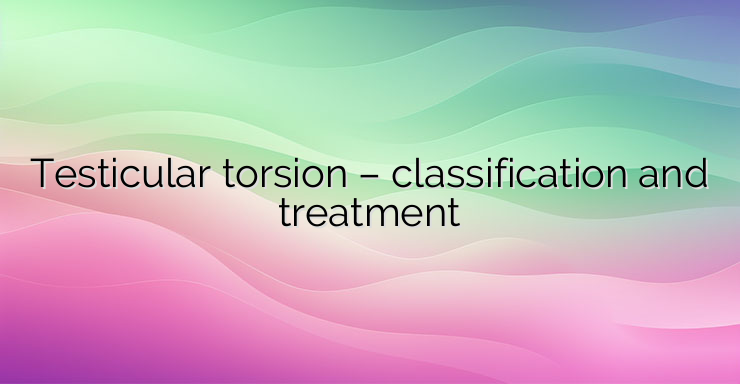Testicular torsion is an extremely common condition in urology emergency rooms. Its frequency is increasing especially among sexually active young men. The disease itself is a wrapping of the structures of the spermatic cord in the inguinal canal or immediately below its anatomical location. Specialists in urology are united in the general opinion that torsion of the testicle from a pathogenetic aspect can be classified into two main types. These are the extravaginal torsion and the intravaginal torsion, respectively. In the first type of testicular torsion, the pathological phenomenon develops already in the neonatal period. It most commonly develops prenatally in the spermatic cord, at the base or end nearest the attachment to the vaginal membrane. The frequency of this disease occurs only in 5% of cases. The second type of torsion – intravaginal, is more specific and is characteristic of the young choir, especially for young people at the age of puberty. In these cases, twisting develops between the sheets of the vaginal membrane. Usually, the condition is manifested by a pathological ascent of the testicles along their vault, which can be both unilateral and bilateral. About 16% of cases are described as involvement in the left testicle and only 2% are described in the statistics as bilateral intravaginal torsion of the testes. The condition requires urgent surgical intervention. What leads the doctor to this diagnosis? At the basis of the diagnosis of torsion of the testicle, a thorough history is of leading importance. Patients usually report an acute onset with very severe, stabbing pain in the scrotum, onset of edema, and absence of fever. Color Doppler is used to verify the diagnosis. The change and pathological occupation of the testicular cord is very well depicted. The testicular contusion, lesion, hematoma or rupture can be seen very well with the help of the ultrasound device. In terms of differential diagnosis, the clinical picture suggests some other acute conditions in the testicles. Such are, for example, acute hematocele, hydrocele, pyocele, abscess, varicocele, spermatocele, development of testicular cyst, epididymal cyst or inguinal hernia. NEWS_MORE_BOX The advantages of diagnostic medicine in the 21st century make it possible to distinguish these conditions from one another in an outpatient setting and to make the correct diagnosis on the spot, so that more adequate treatment can be carried out, leading to a faster recovery for patients and less consequences for them. What are the violations and why is it so dangerous? Testicular torsion is actually a twisting of the spermatic cord. This, in turn, severely disrupts the blood supply to the affected testicle. The degree of twist can be between 180 and 700 degrees. The more the sperm and testicular congestion increases, the more the torsion increases by degrees. According to the force of torsion and its degree, the prognosis for the future testicular atrophy and lesion is determined.It is for this reason that the condition is subject to urgent diagnosis and operative therapy. The treatment is carried out with great urgency and thorough attention by the operating team. In practice, the condition is 100% salvageable if therapeutic measures are taken between 4-8 hours from the onset of symptoms. From there, irreversible processes of tissue necrosis in the testicles begin – tissue death that cannot be restored. The operation is an emergency incision of the scrotum, that is, a surgical opening of the scrotal sac. The twisted testicle is isolated and gradual detorquation is started until a level of satisfactory general condition in the testis is reached and blood circulation in it is normalized. The twisted spermatic cord is then fixed to the scrotum with a suture, which prevents future recurrence of the disease on the corresponding side. Subsequently, the correct drug treatment of the patient and regular monitoring by a specialist in urology are leading in the postoperative period. Clinics usually provide each patient with the opportunity to perform two free examinations in their emergency room after the emergency operation has passed, within a month, when it is expected to be the “hot period” in which the possibility of an acute relapse is quite likely. Tablet forms of myorelaxants and peripheral vasodilators, as well as venotropic drugs, must be applied to the correct surgical treatment. In such conditions, for example, intravenous pentoxifylline is administered during hospital treatment and its subsequent reception of tablets by mouth in a dose of 400 mg twice in the morning and in the evening. Local rubs of gels with a heparin derivative are also important to control impaired blood circulation and to prevent the development of acute testicular thrombosis in the postoperative period.in which the possibility of an acute relapse is quite likely. Tablet forms of myorelaxants and peripheral vasodilators, as well as venotropic drugs, must be applied to the correct surgical treatment. In such conditions, for example, intravenous pentoxifylline is administered during hospital treatment and its subsequent reception of tablets by mouth in a dose of 400 mg twice in the morning and in the evening. Local rubs of gels with a heparin derivative are also important to control impaired blood circulation and to prevent the development of acute testicular thrombosis in the postoperative period.in which the possibility of an acute relapse is quite likely. Tablet forms of myorelaxants and peripheral vasodilators, as well as venotropic drugs, must be applied to the correct surgical treatment. In such conditions, for example, intravenous pentoxifylline is administered during hospital treatment and its subsequent reception of tablets by mouth in a dose of 400 mg twice in the morning and in the evening. Local rubs of gels with a heparin derivative are also important to control impaired blood circulation and to prevent the development of acute testicular thrombosis in the postoperative period.


Leave a Reply